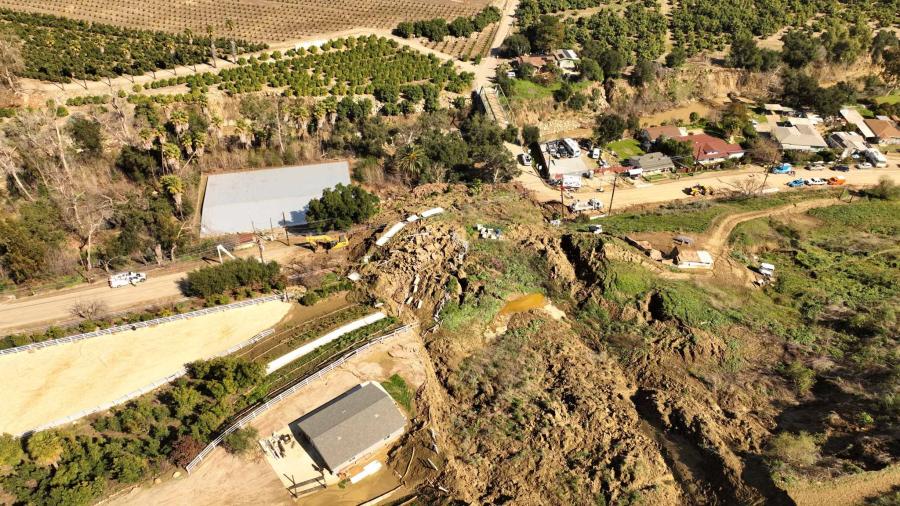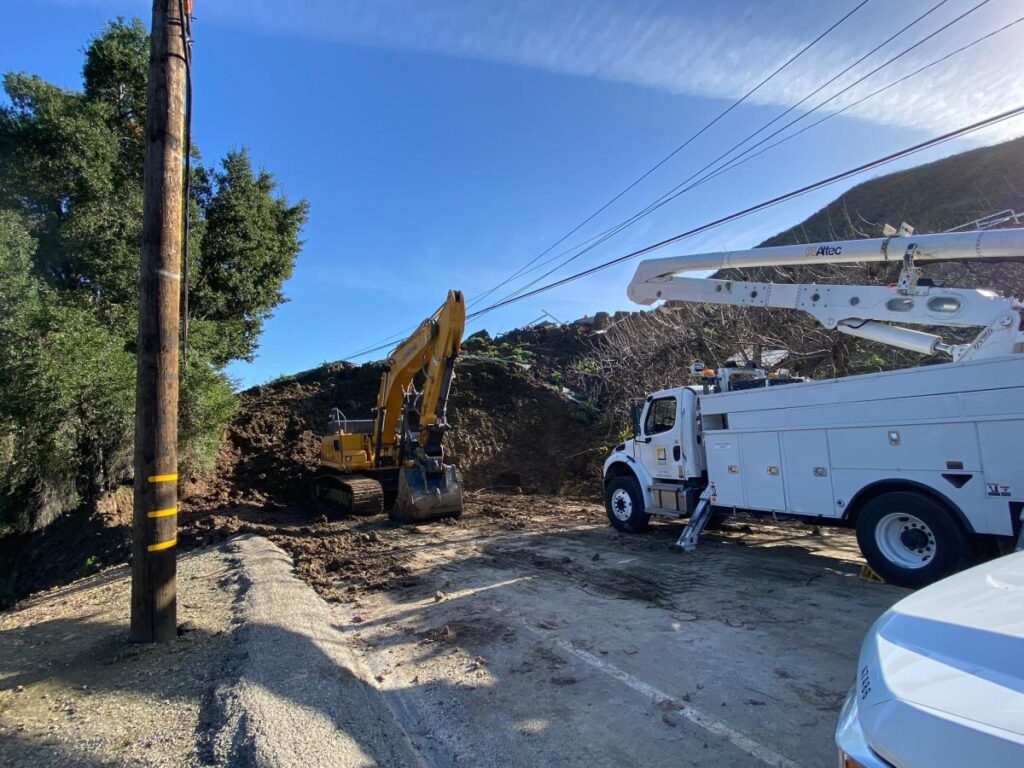Photo courtesy of Caltrans
The length of the retaining wall needed to support this slide is estimated to be up to 360 ft. in length with a height of 40 ft. to 50 ft.
A landslide that began in late February along a section of State Route 150 (SR 150) in Ventura County, Calif., has closed an entire section of the two-lane highway — approximately 150 ft. — due to a series of atmospheric river storms that have hit California.
According to local media reports, the maximum height of the debris field was 70 ft. high north of Santa Paula at Bridge Road.

Photo courtesy of Caltrans
The plan at this point is to stabilize the hillsides, construct a retaining wall and remove the debris. The California Department of Transportation (Caltrans) has hired R&R Demo and Grading Corp. to build the retaining wall. The current plan is to first build the wall and then remove the debris.
“We are ready to act,” said Michael Comeaux, a public relations officer of Caltrans District 7 (Los Angeles and Ventura counties).
The threat of more landslides has kept the roadway closed.
“Caltrans anticipates one lane on this section of Route 150 could open to traffic by the end of May,” said Comeaux, “but that is only a target date and subject to change due to weather and other conditions beyond the control of Caltrans. The mudslide is an active slide and it will be a huge project for Caltrans and the contractor(s) that will be involved.”
Wall Construction
Geotechnical engineers and support staff on-site are busy. They are using drill rigs at various locations that are going as deep as 130 ft. to secure samples to determine the situation impacting the area.
“The lab results and weather data will determine the problem and solution for a safe path” said Comeaux. “The geotechnical team is working at an accelerated schedule. The information will help the design team to develop a retaining wall plan.”
Photo courtesy of Caltrans
The plan is to build the wall along the road using steel beams that will be drilled into the ground. A Caltrans design team is preparing the final design for the retaining wall, along with input from the general contractor.
As part of its long-term solution plan, Caltrans will be purchasing and installing heavy beams (lengths to be determined) to support the retaining wall.
“There may be lead time for procurement of these heavy beams as they may not be commercially available and may need to be manufactured,” Comeaux said. “The estimated length of the retaining wall needed to support this slide at this time is estimated to be up to 360 feet in length with a height of 40 to 50 feet. Multiple rows of ground anchors extending up to 200 feet in length will be constructed through the face of the wall and extend through the slide plane for anchoring the wall. The face of the wall will be buried up to a certain depth which is still to be determined. Considerations, monitoring and analysis will be performed by Caltrans engineers and geologists to determine whether SR150 can be opened during partial construction of the retaining wall.
“The design team has started preliminary work to jumpstart the design process to be ready for construction,” said Comeaux. “It’s all hands on deck to complete the design work quickly. When the design team completes their plans, their report will be handed to Caltrans Construction Division and shared with the GC. All groups are being brought in early and are sharing info to be able to work at top speed. The Construction Division is mobilizing to make preparations to accelerate progress on the parts that they control.”
Caltrans released a recovery plan, pointing out that it is “working on a fast-track schedule to determine the safest and fastest way to stabilize the slide, remove the material from the road and reopen State Route 150 as quickly as possible.”
Comeaux explained why the debris cannot be removed until the retaining wall is constructed, based on initial analysis of the geotechnical team.
“Recent powerful rainstorms saturating the hillside appear to be the primary cause of the landslide.,” he said. “Water can be seen seeping out of the hillside and ponding within the slide, ponding which Caltrans is pumping to remove. Caltrans is very concerned regarding further landslide activity [within the active zone and adjacent hillsides] if debris is removed from the road. Working on a swift timetable, Caltrans has already developed preliminary geotechnical recommendations and design for a retaining wall to stabilize the area. Because of the sensitive geologic nature of the site, the design must be precise to ensure the safety of the area.”
The final geotechnical recommendations are pending the laboratory testing of core samples that were obtained by drilling at five locations.
“The lab tests have been submitted to three different laboratories for accelerated testing since there is limited testing equipment available at each laboratory,” he added. “Slope analysis and geotechnical recommendations are being expedited due to the high priority to reopen SR 150 as soon as possible. Caltrans engineers will refine their model within two days of receiving the laboratory test results to provide the necessary geotechnical recommendations and retaining wall plans. In addition, the laboratory test results will also be used to analyze whether more than one retaining wall is necessary. If a second wall is required, it will not impact the opening of SR 150 since it would be constructed up slope.”
Simply removing the material now is not an option due to the topography.
“The hillside consists of multiple nested slides, which have moved in the past leaving exposed visible scarps,” said Comeaux. “The slide movement in February deposited slide debris on SR 150, debris which is currently acting as a temporary buttress to support the material uphill, both vertically and laterally. More slides could occur if material is removed. Caltrans is closely monitoring the active slide and the adjacent areas for additional slope movement.”
Photo courtesy of Caltrans
The recovery plan provided details on the DOT’s reaction to the landslide.
“[We] started this complex investigation process immediately after the slide occurred,” said Comeaux. “Caltrans secured the area and monitored the slide for further movement, and Caltrans continues monitoring it closely. Caltrans immediately developed a plan of action for reopening Route 150 as quickly as possible. Caltrans informed motorists, the community, local leaders, elected officials and others regarding this emergency and what’s ahead, with close coordination among agencies at the local, state, and federal levels to respond to the community’s needs. [We also] immediately started the geotechnical investigation of the slide area [and] arranged an emergency contractor to provide additional equipment and workers. Caltrans assembled teams of experts in design, construction and emergency operations for an all-hands-on-deck, expedited response to this event.”
The recovery plan also addressed concerns about the road not being reopened prior the start of the fire season.
“Caltrans is confident that the road will be open well before fire season and is coordinating the status of repairs with partner agencies such as the Ventura County Fire Department,” said Comeaux. CEG
Read the full article here

